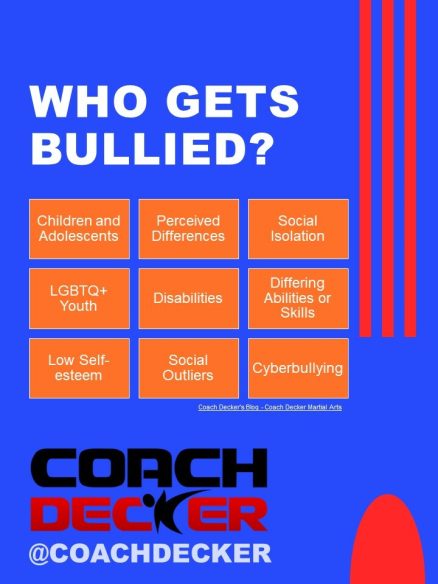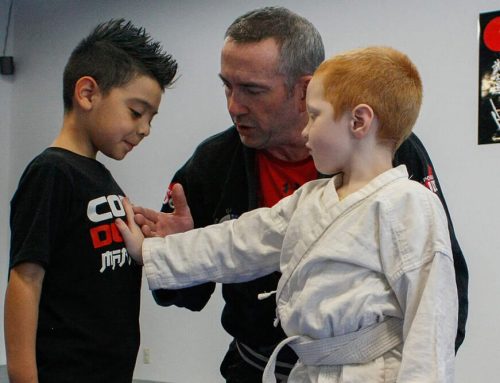 WHO
WHO
Bullying can target individuals from all walks of life, and there is no single profile that determines who may be a target of bullying. However, some factors can make individuals more susceptible to bullying.
Bullying is prevalent in schools, and children and teenagers are often the primary targets. This can be due to their age, vulnerability, or perceived differences. Bullies often target those they perceive as different from themselves, whether it’s because of race, ethnicity, gender, sexual orientation, religion, disability, appearance, or other characteristics.
Children and adults who are socially isolated or have few friends may be more vulnerable to bullying. Bullies may see them as easy targets. LGBTQ+ youth are at a higher risk of being bullied due to their sexual orientation or gender identity. This is known as homophobic or transphobic bullying. Individuals with physical or intellectual disabilities can be targets of bullying, often because bullies perceive them as easy targets. In competitive environments, individuals who excel in academics, sports, or other areas may be bullied for their achievements. Those with low self-esteem may be more vulnerable to bullying because they may not assert themselves or seek help. People who do not conform to social norms or who have unconventional interests or behaviors may be bullied for their non-conformity. And in the digital age, anyone with an online presence can be a victim of cyberbullying, regardless of their age or background.
Just remember that anyone, regardless of their characteristics, can be a target of bullying. And no one deserves to be bullied or harassed.
WHAT
Bullying is a deliberate and repeated aggressive behavior intended to hurt, harm, or intimidate someone who is perceived as being less powerful or vulnerable. It can take many forms and occur in various settings, including schools, workplaces, online, and within communities. Bullying involves an imbalance of power, where the person being bullied often has difficulty defending themselves.
Common forms of bullying include:
Verbal Bullying: This involves using hurtful words, name-calling, insults, teasing, or threats to belittle or humiliate the target.
Physical Bullying: Physical bullying includes acts of aggression, such as hitting, pushing, kicking, or other forms of physical harm.
Relational Bullying: Also known as social or emotional bullying, this type of bullying involves damaging a person’s reputation or relationships. It may include spreading rumors, exclusion, or manipulation.
Cyberbullying: Bullying can also occur online through digital means. This includes sending hurtful or threatening messages, spreading rumors through social media, sharing embarrassing pictures or videos, and other forms of harassment in the digital space.
Sexual Bullying: This form of bullying involves unwanted sexual comments, advances, or harassment, which can be verbal, physical, or online.
Racial, Religious, or Cultural Bullying: Bullying based on a person’s race, religion, or cultural background involves derogatory comments, stereotypes, and discriminatory behavior.
Homophobic or Transphobic Bullying: Targeting someone based on their sexual orientation or gender identity can take the form of derogatory comments, exclusion, or threats.
It’s important to note that bullying is not a one-time occurrence; it typically involves a pattern of behavior that occurs over time. The effects of bullying can be severe and may include physical and emotional distress, low self-esteem, anxiety, depression, and, in some cases, long-term psychological and emotional trauma.
WHERE
Bullying can occur in various settings, and it is not limited to a specific location.

Bullying can also take place within neighborhoods and communities, often involving children or teenagers who live in the same area. It may involve verbal or physical harassment.
Workplace bullying, often referred to as “workplace harassment,” can occur in office environments, factories, retail settings, and other places of employment. It may involve verbal abuse, exclusion, or other forms of mistreatment by colleagues or superiors.
With the rise of the internet and social media, cyberbullying has become a significant concern. This type of bullying occurs through digital platforms, such as social networking sites, emails, text messages, and online gaming communities.
In addition to general online bullying, bullying is common within the context of online gaming. Players may engage in abusive language, harassment, or other forms of mistreatment during gaming sessions.
Social settings such as parties, gatherings, and clubs can also be locations where bullying occurs. It may involve social exclusion, verbal abuse, or physical confrontations.
Bullying can happen within the context of sports teams, clubs, or extracurricular activities. This can include hazing, exclusion, or intimidation of team members or participants.
While less common, bullying can even happen within a family environment. Sibling rivalry and mistreatment by family members can sometimes be considered a form of bullying.
HOW
Stopping a bully is important for the well-being of both the victim and the community. Here are some steps you can take to address bullying:
- Support the Victim:
If you witness someone being bullied, offer support and comfort to the victim. Let them know they are not alone, and encourage them to talk to a trusted adult about the situation.
- Stay Safe:
If you feel safe doing so, directly intervene calmly and confidently telling the bully to stop their behavior. Do not put yourself at risk, and avoid using physical violence.
- Report the Bullying:
If you’re a student, report the bullying to a trusted teacher, school counselor, or principal. If you’re an adult, report it to the appropriate authority figure, such as a supervisor or HR department in a workplace.
- Document the Bullying:
Keep a record of incidents, including dates, times, locations, and descriptions of what occurred. This documentation may be useful in supporting the victim’s case.
- Encourage Open Communication:
Encourage open dialogue with the victim and others who may have witnessed the bullying. The more information you have, the better you can address the issue.
- Involve Parents/Guardians:
If you’re a student, inform your parents or guardians about the situation. If you’re an adult, consider discussing the issue with the victim’s parents or guardians if they are comfortable with it.
- Seek Professional Help:
In some cases, bullies may have underlying issues that contribute to their behavior. It may be necessary for the bully to seek professional help, such as counseling, to address these issues.
- Encourage Education and Awareness:
Promote anti-bullying programs and awareness campaigns in your school or workplace. Education and awareness can help prevent bullying from occurring in the first place.
- Support Policies and Procedures:
Advocate for strong anti-bullying policies and procedures within your school or workplace. These policies should provide clear guidelines on how bullying will be addressed and the consequences for bullies.
- Involve Law Enforcement:
In cases of severe bullying or when the safety of the victim is at risk, involve law enforcement as a last resort. Bullying that involves criminal behavior, such as harassment, assault, or cyberbullying, may require legal intervention.
Here is a video we recommend you watch on the subject of Bullying:
CONCLUSION
Remember that addressing bullying is a collective effort, and it’s important to create a culture of respect, empathy, and kindness in your community. Encourage everyone to take a stand against bullying and work together to create a safe and supportive environment for all.
Efforts are made in many schools, workplaces, and communities to prevent and address bullying by implementing anti-bullying policies, awareness campaigns, and support systems for those who have been bullied. Encouraging open communication and a culture of respect is essential in preventing and addressing bullying. It’s crucial to address and prevent bullying in all settings by promoting a culture of respect, empathy, and kindness and by implementing anti-bullying policies and awareness campaigns.
The key is to promote a culture of respect, empathy, and kindness, where bullying is not tolerated, and individuals are supported in reporting and addressing bullying incidents. If you or someone you know is experiencing bullying, it’s essential to seek help and support from trusted individuals, authorities, or professionals.
Additional Resources:
Mesa Public Schools webpage on bullying:
Mesa Public Schools » Bullying Resources (mpsaz.org)
Mesa Public Schools policy on bullying:
Active Policies – 63 East Main Street #101 | Mesa, Arizona 85201 | 480-472-0000 BoardDocs®️️ Pro
Mesa Public Schools regulation on bullying:
Active Policies – 63 East Main Street #101 | Mesa, Arizona 85201 | 480-472-0000 BoardDocs®️️ Pro
Other resources:
StopBullying.gov
Rachel’s Challenge | Bullying & School Violence Prevention Program (rachelschallenge.org)
Bullying (nationalsafeplace.org)


 WHO
WHO



